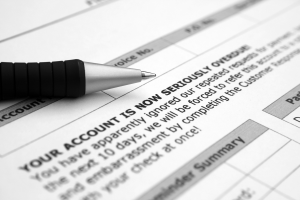 How to Calculate Accounts Receivable Turnover Ratio
How to Calculate Accounts Receivable Turnover Ratio
Windfall profits but no cash in the bank? Your accounts receivable may be the culprit. Today, I’m going to show you how to the calculate accounts receivable turnover ratio and also talk about solutions if yours is too high.
Accounts Receivable (A/R)
Before going into calculations and such, it’s important to understand accounts receivables (A/R) first. A/R is an asset. We talked about assets and liabilities when creating a balance sheet. In a nutshell, accounts receivables is the money owed or debt owed to you by clients and customers. The debt may be in the form of loans, lines of credit, invoices, bills, etc. I go into more detail in an earlier post. Needless to say, it’s money (assets) you can’t access because you don’t have them in your hot little hands for some reason or another.
Turnover Ratio
The turnover refers to the average number of times a particular line item can complete a cycle in a given year, translated into a ratio. There are turnover ratios for accounts receivables, inventory, and payables. As I mentioned, today we’re going to focus on accounts receivable. One might ask why this ratio matters? Well, your A/R turnover ratio is an indicator of how well you’re managing credit extended to your customers and clients. A high A/R turnover ratio is the reason some companies can be making sales/money hand over fist, but can’t seem to scrape together enough money to pay the bills.
The Calculation
Let’s hit the calculation.
| A/R Turnover Ratio = | Sales
|
| Accounts Receivable |
So where do you get these numbers? You’re going to find your sales in the income statement. If you used the free worksheet I provided, you’re going to find the answer you’re looking for in the last column under the line item Total Revenue. The accounts receivable, as I mentioned above is in the balance sheet.
So, let’s do an example. Let’s say I run a clothing boutique that extends credit to my customers. This year, my boutique had a great year! In fact, it’s my best year yet. I sold $353,000 in sales this time around, which was 23% more than last year. In part, I think it’s due to allowing my customers to participate in my new store credit program. And boy have they been taking advantage of it. I checked my books and my customers have $141,200 in outstanding credit.
Using the example above we have:
A/R Turnover Ratio =
| A/R Turnover Ratio = | $353,000
|
= 2.5 |
| $141,200 |
My example yield a A/R turnover ratio of 2.5. That means, in that particular year, I’m able to collect my accounts receivable ($141,200) 2.5 times per year. When it comes to the A/R Turnover Ratio, the higher the number the better. Why? It means you’re bringing in money owed you faster.
Accounts Receivable Turnover Days
For some the turnover ratio is easy to understand and good enough. For others, like me, more is needed to understand the ramifications. So, we’re going to take it a little bit further and look at it in turnover days. Turnover days refers to the number of days it takes for you to receive your cash from clients on average. The calculation looks like this:
| A/R Turnover Days = | 360
|
| A/R Turnover Ratio |
We’re using 360 as the number of days in a year (30 days/mo). Yes… I know we have 364/365 days depending on leap years. We’re doing simple accounting this time around. So, using my previous example, the calculation is going to look like this:
| A/R Turnover Days = | 360
|
= 144 |
| 2.5 |
As we can see, with a 2.5 turnover ratio, it’s taking me on average 144 days to get paid for the sales I make. So, if I sell a pair of boots on credit January 1, I didn’t get paid for those boots May 25 that year. Ouch!
If companies are running their business like that (especially startups), it’s no wonder they’re having problem paying their bills.
For those who want to check your answers, I’ve added a little calculator.
Only enter numbers as shown in the examples below.
= Accounts Receivable
A/R Turnover Ratio =
A/R Turnover Days =
Managing Accounts Receivable
The idea of running a business is to get paid for the products and services you render. Extend credit to customers is a wonderful gesture and can bring in more business. However, it’s important to be smart about doing it. Let’s talk about some ways to increase your accounts receivable ratio.
- Create a tradeoff for extending credit. Once in a while, I’ll get a client in my office who offers credit or wants to offer credit to their customers. However, they haven’t thought about monetizing the value of offering credit. Instead, they take the uncle or grandma role to extending credit to customers. That is, they have no interest associated with the borrowed money. It’s nice to extend credit to customers, as it can encourage customers to complete the sale, purchase more, or even help create loyalty. However, you’re not grandpa or their aunt. It’s okay to charge interest on accounts that aren’t paid within a certain time. Just be sure to follow the credit laws when extending credit.
 No penalties for late payments. Again, you’re not a relative doing favors. You’re a business owner. As such, consider charging late fees. Companies who don’t have late fees put themselves at risk to being on the bottom of the totem pole when it comes to satisfying debt. Make your debt important to the customer.
No penalties for late payments. Again, you’re not a relative doing favors. You’re a business owner. As such, consider charging late fees. Companies who don’t have late fees put themselves at risk to being on the bottom of the totem pole when it comes to satisfying debt. Make your debt important to the customer.- Discounts for satisfying debt early. You might even consider offering a discount for customers who satisfy their debt in full early. This works great in the service industry, particularly for customers who’ve transitioned into the realm of client. For example, you might offer a 2%/20 Net 30 discount (2% discount on bills satisfied within 20 days with the full bill due in 30 days). It’s a way of saying thank you for your business and for being a good business partner.
- Rewards for satisfying debt early. This works very similarly to the discount. However, you might offer a reward in the form a store credit. In essence, you turn your store credit card into a reward card. Not only do you get paid on time, but you also have given your customer a reason for returning.
- Extend credit selectively. Just because someone is willing to spend more money, if they can put it on credit, doesn’t mean you should extend credit to them. Don’t be afraid to run credit checks prior to offering credit.
 Send notices. I’ve had clients who extend credit, but never send notices to their clients. Then they fail to understand why their clients haven’t paid the bill. If you’re not receiving your money on time, YOU need to reach out to your customer. Perhaps they did sent the payment, but it’s lost in the mail, sent to the wrong address or bank account. The customer may think the debt is satisfied, but because you’ve failed to keep in contact, a huge mess may be brewing. Or perhaps the customer didn’t send a payment and you’ve become out of sight, out of mind. Either way, you’re not seeing the money because of poor communication.
Send notices. I’ve had clients who extend credit, but never send notices to their clients. Then they fail to understand why their clients haven’t paid the bill. If you’re not receiving your money on time, YOU need to reach out to your customer. Perhaps they did sent the payment, but it’s lost in the mail, sent to the wrong address or bank account. The customer may think the debt is satisfied, but because you’ve failed to keep in contact, a huge mess may be brewing. Or perhaps the customer didn’t send a payment and you’ve become out of sight, out of mind. Either way, you’re not seeing the money because of poor communication.- Clear credit policies. I’m saving the best for last. Regardless of the methods you implement to manage accounts receivables, I high encourage you to set clear credit policies. All the methods you choose to use above, should be outlined in your credit policies and provided to the customer.
What policies do you have in place for extending credit?




Leave A Comment